
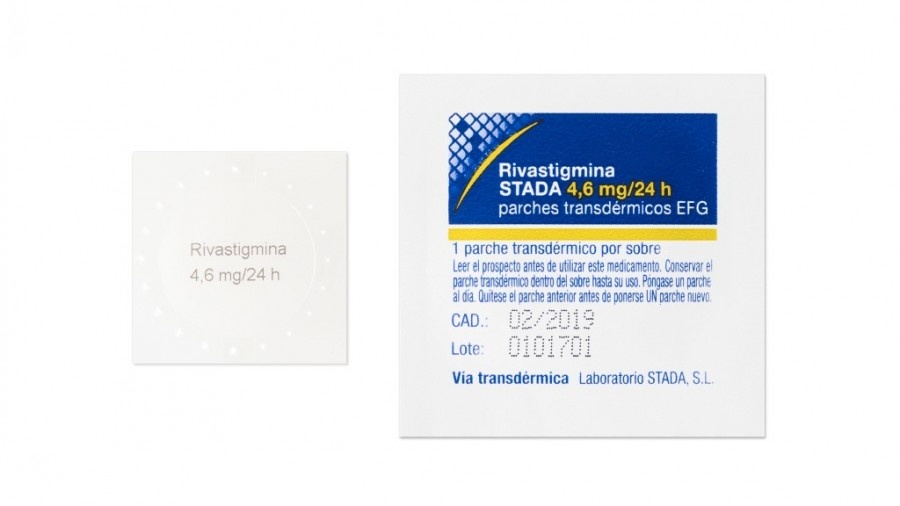
РИВАНЕКС 4,6 мг/24 часа ТРАНСДЕРМАЛЬНЫЕ ПЛАСТЫРИ

Спросите врача о рецепте на РИВАНЕКС 4,6 мг/24 часа ТРАНСДЕРМАЛЬНЫЕ ПЛАСТЫРИ

Инструкция по применению РИВАНЕКС 4,6 мг/24 часа ТРАНСДЕРМАЛЬНЫЕ ПЛАСТЫРИ
Введение
Проспект: информация для пациента
Риванекс 4,6 мг/24ч трансдермальные пластыри ЕФГ
Ривастигмина
Прочитайте внимательно весь проспект перед началом приема этого лекарства, поскольку он содержит важную информацию для вас.
- Сохраните этот проспект, поскольку вам может потребоваться перечитать его.
- Если у вас есть какие-либо вопросы, проконсультируйтесь с вашим врачом или фармацевтом.
- Это лекарство было назначено только вам, и не следует давать его другим людям, даже если у них такие же симптомы, как у вас, поскольку оно может нанести им вред.
- Если вы испытываете побочные эффекты, проконсультируйтесь с вашим врачом или фармацевтом, даже если это побочные эффекты, которые не указаны в этом проспекте. См. раздел 4.
Содержание проспекта
- Что такое Риванекс и для чего он используется
- Что нужно знать перед началом использования Риванекса
- Как использовать Риванекс
- Возможные побочные эффекты
- Хранение Риванекса
- Содержание упаковки и дополнительная информация
1. Что такое Риванекс и для чего он используется
Активное вещество Риванекса - ривастигмина.
Ривастигмина относится к группе ингибиторов холинэстеразы. У пациентов с болезнью Альцгеймера определенные нервные клетки умирают в мозге, что приводит к низким уровням нейротрансмиттера ацетилхолина (вещества, которое позволяет нервным клеткам общаться друг с другом). Ривастигмина действует, блокируя ферменты, которые разрушают ацетилхолин: ацетилхолинэстеразу и бутирилхолинэстеразу. Блокируя эти ферменты, Риванекс позволяет увеличить уровень ацетилхолина в мозге, что помогает уменьшить симптомы болезни Альцгеймера.
Риванекс используется для лечения взрослых пациентов с болезнью Альцгеймера легкой или умеренной степени, прогрессивным заболеванием мозга, которое постепенно влияет на память, интеллектуальные способности и поведение.
2. Что нужно знать перед началом использования Риванекса
Не используйте Риванекс:
- если вы аллергичны к ривастигмине или к любому другому компоненту этого лекарства (перечисленному в разделе 6).
- если у вас когда-либо была аллергическая реакция на подобное лекарство (производные карбамата).
- если у вас есть кожная реакция, которая распространяется за пределы размера пластыря, если есть более сильная местная реакция (такая как пузыри, увеличение воспаления кожи, отек) и если нет улучшения в течение 48 часов после удаления трансдермального пластыря.
Если вы находитесь в одной из этих ситуаций, сообщите об этом вашему врачу и не используйте ривастигмину.
Предостережения и меры предосторожности
Проконсультируйтесь с вашим врачом перед началом использования этого лекарства:
- если у вас есть или было когда-либо нерегулярное сердцебиение (пульс) или замедленное сердцебиение.
- если у вас есть или было когда-либо активная язва желудка.
- если у вас есть или было когда-либо трудности с мочеиспусканием.
- если у вас есть или было когда-либо судороги.
- если у вас есть или было когда-либо бронхialная астма или тяжелое респираторное заболевание.
- если у вас есть тремор.
- если у вас низкий вес.
- если у вас есть желудочно-кишечные реакции, такие как тошнота, рвота и диарея. Вы можете обезвожиться (потерять большое количество жидкости), если рвота или диарея продолжаются.
- если у вас есть проблемы с печенью (печеночная недостаточность).
Если вы находитесь в одной из этих ситуаций, ваш врач может считать необходимым более тщательно следить за вами во время лечения.
Если вы не использовали пластыри в течение нескольких дней, не накладывайте новый без предварительной консультации с вашим врачом.
Дети и подростки
Ривастигмина не должна использоваться в педиатрической популяции для лечения болезни Альцгеймера.
Другие лекарства и Риванекс
Сообщите вашему врачу или фармацевту, если вы используете, недавно использовали или можете использовать любое другое лекарство.
Ривастигмина может взаимодействовать с антихолинergicными лекарствами, некоторые из которых используются для облегчения спазмов или судорог в желудке (например, дцикломин), для лечения болезни Паркинсона (например, амантадин) или для предотвращения укачивания (например, дифенгидрамин, скополамин или меклетин).
Это лекарство не должно приниматься одновременно с метоклопрамидом (лекарством, используемым для облегчения или предотвращения тошноты и рвоты). Одновременный прием этих двух лекарств может вызвать проблемы, такие как жесткость в конечностях и тремор рук.
В случае если вам необходимо пройти хирургическую операцию во время использования ривастигмины, сообщите вашему врачу, что вы используете это лекарство, поскольку оно может чрезмерно усилить эффекты некоторых миорелаксантов анестезии.
Следует быть осторожным при использовании этого лекарства вместе с бета-блокаторами (лекарствами, такими как атенолол, используемыми для лечения гипертонии, стенокардии и других сердечных заболеваний). Одновременный прием этих двух лекарств может вызвать осложнения, такие как снижение частоты сердечных сокращений (брадикардия), что может привести к обмороку или потере сознания.
Использование Риванекса с пищей, напитками и алкоголем
Это лекарство может использоваться с пищей, напитками и алкоголем.
Беременность, лактация и фертильность
Если вы беременны или кормите грудью, считаете, что можете быть беременной или планируете стать беременной, проконсультируйтесь с вашим врачом или фармацевтом перед использованием этого лекарства.
Если вы беременны, необходимо оценить преимущества использования ривастигмины перед возможными побочными эффектами для плода. Не следует использовать это лекарство во время беременности, если только это не абсолютно необходимо.
Не следует кормить грудью во время лечения ривастигминой.
Вождение и использование машин
Ваше заболевание может повлиять на вашу способность управлять транспортными средствами или использовать машины, и вы не должны выполнять эти действия, если только ваш врач не скажет вам, что это безопасно.
Риванекс пластыри могут вызывать головокружение и сонливость, особенно в начале лечения или при увеличении дозы. Если вы испытываете эти эффекты, не следует управлять транспортными средствами или использовать машины.
3. Как принимать Риванекс
Следуйте точно инструкциям по применению этого лекарства, указанным вашим врачом. В случае сомнений проконсультируйтесь с вашим врачом или фармацевтом.
Важно:
- Удалите предыдущий пластырь перед применением нового.
- Используйте только один пластырь в день.
- Не разрезайте пластырь на части.
- Применяйте пластырьfirmly к коже ладонью руки в течение как минимум 30 секунд.
Как начать лечение
Ваш врач укажет вам наиболее подходящую дозу ривастигмины в вашем случае.
- Обычно лечение начинается с ривастигмины 4,6 мг/24ч.
- Рекомендуемая ежедневная доза обычно составляет ривастигмина 9,5 мг/24ч. Если эта доза хорошо переносится, лечащий врач может рассмотреть возможность ее увеличения до 13,3 мг/24ч.
- Используйте только один пластырь ривастигмины одновременно и замените пластырь на новый через 24 часа.
Во время лечения ваш врач может корректировать дозу в зависимости от ваших индивидуальных потребностей.
Если вы не использовали пластыри в течение трех дней, не накладывайте новый без предварительной консультации с вашим врачом. Лечение трансдермальным пластырем может быть возобновлено с той же дозы, если оно не было прервано более чем на три дня. В противном случае ваш врач может назначить вам начать лечение с ривастигмины 4,6 мг/24ч.
Где применять пластырь Риванекс
- Перед применением пластыря убедитесь, что кожа чиста, суха и без волос, без порошков, масла, увлажнителя или лосьона, которые могут помешать пластырю прилипнуть к коже, без порезов, покраснений или раздражений.
- Удалите предыдущий пластырь перед применением нового. Ношение нескольких пластырей на вашем теле может привести к чрезмерному воздействию этого лекарства и это может быть потенциально опасным.
- Применяйте только один пластырь в день в одной из возможных зон, как показано на следующих схемах:
- Верхняя левая или верхняя правая часть руки
- Верхняя левая или верхняя правая часть груди (избегая молочных желез у женщин)
- Верхняя левая или верхняя правая часть спины
- Нижняя левая или нижняя правая часть спины
Каждые 24 часа удалите предыдущий пластырь перед применением нового в одной из следующих возможных зон.
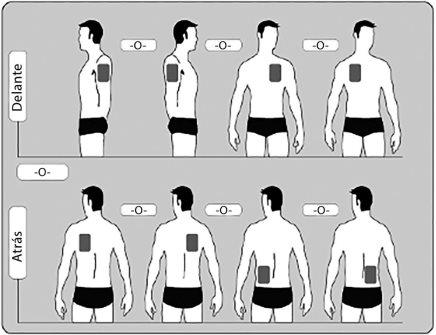
Каждый раз, когда вы меняете пластырь, удалите предыдущий пластырь перед применением нового в другом месте на коже (например, один день на правой стороне тела, а на следующий день - на левой стороне; или один день на верхней части тела, а на следующий день - на нижней части). Подождите как минимум 14 дней, прежде чем применить новый пластырь точно в том же месте на коже.
Как применять пластыри Риванекс
Пластыри Риванекса тонкие, плоские и непрозрачные, и они прикрепляются к коже. Каждый пластырь находится в отдельном пакете, который защищает его до тех пор, пока вы не будете готовы его применить. Не открывайте пакет и не удаляйте пластырь до момента его применения.
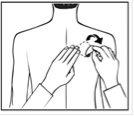
Удалите предыдущий пластырь перед применением нового.
Пациенты, которые начинают лечение впервые, и пациенты, которые возобновляют лечение Риванексом после перерыва, должны начать с второй фигуры.

Каждый пластырь находится в отдельном защитном пакете. Открывайте пакет только тогда, когда будете готовы применить пластырь. Разрежьте пакет вдоль линии точки с помощью ножниц и удалите пластырь из пакета.
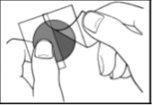
Защитная пленка покрывает клеящую сторону пластыря. Удалите первую часть защитной пленки, не касаясь пальцами клеящей стороны пластыря.
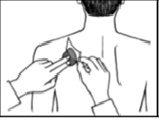
Поместите клеящую сторону пластыря на верхнюю или нижнюю часть спины или на верхнюю часть руки или на грудь, а затем удалите вторую часть защитной пленки.
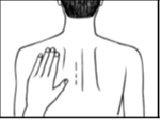
Применяйте пластырьfirmly к коже ладонью руки в течение как минимум 30 секунд и убедитесь, что края хорошо приклеены.
Если это помогает, вы можете написать на пластыре, например, день недели, с помощью тонкого маркера.
Вы должны носить пластырь постоянно до момента его замены на новый. Когда вы будете применять новый пластырь, вы можете попробовать разные зоны, чтобы найти те, которые будут наиболее удобными для вас и где одежда не будет тереться о пластырь.
Как удалить пластыри Риванекс
Аккуратно потяните за один из краев пластыря, чтобы медленно удалить его с кожи. Если остаются клеевые остатки на коже, смочите область теплой водой и мягким мылом или используйте детское масло, чтобы удалить их. Не следует использовать алкоголь или другие растворители (например, жидкости для снятия лака или другие растворители).
После удаления пластыря руки должны быть вымыты с мылом или водой. В случае контакта с глазами или если глаза становятся красными после обращения с пластырем, необходимо сразу же промыть их большим количеством воды и обратиться за медицинской консультацией, если симптомы не исчезают.
Можно ли носить пластыри Риванекс во время купания, плавания или воздействия солнца?
- Купание, плавание или душ не должны повлиять на пластырь. Убедитесь, что он не отслаивается частично во время этих действий.
- Не подвергайте пластырь воздействию внешних источников тепла (например, интенсивного солнечного света, сауны, солярия) в течение длительного времени.
Что делать, если пластырь отвалился
Если пластырь отвалился, примените новый на оставшееся время дня и замените его на следующий день в обычное время.
Когда и как долго следует применять пластыри Риванекс
- Чтобы получить пользу от лечения, необходимо применять новый пластырь каждый день, желательно в одно и то же время.
- Используйте только один пластырь Риванекса одновременно и замените пластырь на новый через 24 часа.
Если вы применили слишком много Риванекса
Если вы случайно применили более одного пластыря, удалите все пластыри с кожи, проконсультируйтесь с вашим врачом или фармацевтом или позвоните в Центр токсикологической информации, телефон: 91 562 04 20, указав лекарство. Некоторые люди, которые случайно приняли слишком большое количество ривастигмины, испытывали тошноту, рвоту, диарею, высокое кровяное давление и галлюцинации. Также могут возникнуть замедление частоты сердечных сокращений и обморок.
Если вы забыли использовать Риванекс
Если вы обнаружите, что забыли применить пластырь, примените его сразу же. На следующий день примените следующий пластырь в обычное время. Не применяйте два пластыря, чтобы компенсировать пропущенный.
Если вы прекратили лечение Риванексом
Сообщите вашему врачу или фармацевту, если вы перестали использовать пластыри.
Если у вас есть какие-либо другие вопросы о использовании этого лекарства, проконсультируйтесь с вашим врачом или фармацевтом.
4. Возможные побочные эффекты
Как и все лекарства, это лекарство может вызывать побочные эффекты, хотя не все люди испытывают их.
Вы можете испытывать побочные эффекты чаще при начале лечения или при увеличении дозы. Обычно побочные эффекты постепенно исчезают, когда ваш организм привыкает к лекарству.
Если вы заметите любой из следующих побочных эффектов, которые могут быть серьезными, удалите пластырь и немедленно проконсультируйтесь с вашим врачом:
Частые (могут возникать у до 1 из 10 человек)
- Потеря аппетита.
- Головокружение.
- Чувство беспокойства или онемения.
- Неспособность контролировать мочеиспускание (недержание мочи).
Редкие (могут возникать у до 1 из 100 человек)
- Проблемы с сердечным ритмом, такие как замедленное сердцебиение.
- Галлюцинации (видение вещей, которые на самом деле не существуют).
- Язва желудка.
- Обезвоживание (потеря большого количества жидкости).
- Гиперактивность (высокий уровень активности, беспокойство).
- Агрессивность.
Очень редкие (могут возникать у до 1 из 1000 человек)
- Падения.
Чрезвычайно редкие (могут возникать у до 1 из 10 000 человек)
- Жесткость рук и ног.
- Тремор рук.
Частота не известна (не может быть оценена из доступных данных)
- Аллергическая реакция в месте применения пластыря, такая как пузыри или воспаление кожи.
- Ухудшение симптомов болезни Паркинсона - таких как тремор, жесткость и трудности с движением.
- Воспаление поджелудочной железы - симптомы включают сильную боль в верхней части живота, часто сопровождаемую тошнотой или рвотой.
- Быстрый или нерегулярный сердечный ритм.
- Высокое кровяное давление.
- Судороги (припадки).
- Печеночные расстройства (желтуха кожи, желтуха белого глаза, необычное потемнение мочи или необъяснимая тошнота, рвота, усталость и потеря аппетита).
- Изменения в анализах, показывающих функцию печени.
- Чувство беспокойства.
- Кошмары.
- Синдром Писа (состояние, характеризующееся непроизвольным сокращением мышц и аномальным наклоном тела и головы в сторону).
Если вы заметите любой из вышеуказанных побочных эффектов, удалите пластырь и немедленно проконсультируйтесь с вашим врачом.
Другие побочные эффекты, испытанные при использовании ривастигмины в капсулах или в виде раствора для приема внутрь, и которые могут возникнуть при использовании пластырей:
Частые (могут возникать у до 1 из 10 человек)
- Избыточное слюноотделение.
- Потеря аппетита.
- Чувство беспокойства.
- Чувство общего недомогания.
- Тремор или чувство путаницы.
- Увеличение потоотделения.
Редкие (могут возникать у до 1 из 100 человек)
- Нерегулярный сердечный ритм (например, быстрый сердечный ритм).
- Трудности со сном.
- Случайные падения.
Очень редкие (могут возникать у до 1 из 1000 человек)
- Язва в кишечнике.
- Судороги (припадки).
- Боль в груди - вероятно, вызванная спазмом в сердце.
Чрезвычайно редкие (могут возникать у до 1 из 10 000 человек)
- Кровотечение в желудочно-кишечном тракте - проявляется как кровь в каловых массах или при рвоте.
- Высокое кровяное давление.
- Воспаление поджелудочной железы - симптомы включают сильную боль в верхней части живота, часто сопровождаемую тошнотой или рвотой.
- Кровотечение в желудочно-кишечном тракте - проявляется как кровь в каловых массах или при рвоте.
- Галлюцинации (видение вещей, которые на самом деле не существуют).
- Некоторые люди, которые испытывали сильную рвоту, имели разрыв части пищеварительного тракта, соединяющего рот с желудком (эзофагус).
Сообщение о побочных эффектах
Если вы испытываете любой побочный эффект, проконсультируйтесь с вашим врачом или фармацевтом, даже если это возможные побочные эффекты, которые не указаны в этом проспекте. Вы также можете сообщить о них напрямую через Испанскую систему фармаковигиланса для лекарств для человека, https://www.notificaRAM.es. Сообщая о побочных эффектах, вы можете внести свой вклад в предоставление более полной информации о безопасности этого лекарства.
5. Хранение Риванекса
Это лекарство не требует специальной температуры хранения. Хранить в оригинальной упаковке, чтобы защитить от света. Хранить трансдермальный пластырь внутри пачки до его использования.
Хранить это лекарство вне поля зрения и досягаемости детей.
Не использовать это лекарство после даты истечения срока годности, указанной на коробке и пачке. Дата истечения срока годности - последний день месяца, указанного.
Не использовать никакой пластырь, если вы заметите, что он поврежден или имеет признаки вскрытия.
После снятия пластыря сложить его пополам с клеевой стороной внутрь и прижать. После помещения в оригинальную пачку, при избавлении от пластыря, убедитесь, что он находится вне досягаемости детей. После снятия пластыря не трогайте глаза и тщательно мойте руки с мылом и водой.
Лекарства не должны выбрасываться в канализацию или мусор. Поместите упаковки и лекарства, которые вам больше не нужны, в Пункт SIGRE аптеки. В случае сомнений, спросите у вашего фармацевта, как избавиться от упаковок и лекарств, которые вам больше не нужны. Таким образом, вы поможете защитить окружающую среду.
6. Содержание упаковки и дополнительная информация
Состав Риванекса
Активное вещество - ривастигмина. Каждый пластырь выделяет 4,6 мг ривастигмины в течение 24 часов, имеет площадь 5 см2 и содержит 9 мг ривастигмины.
Другие компоненты: внешний слой [полиэстеровая пленка, полиэстеровая пленка с силиконом, полиэстеровая пленка с фтором], адгезивная матрица [акриловый адгезив (DURO-TAK87-235A), акрилатный сополимер (PLASTOID B) и этилацетат], адгезивный слой [силиконовый адгезив (BIO-PSA 7-4302)] и чернила.
Внешний вид продукта и содержание упаковки
Риванекс 4,6 мг/24 ч трансдермальные пластыри выпускаются в виде трансдермального пластыря, состоящего из трех слоев. Внешний слой имеет округлую форму. Каждая пачка содержит один трансдермальный пластырь.
Риванекс 4,6 мг/24 ч трансдермальные пластыри доступны в упаковках, содержащих 30 или 60 пачек. Возможно, что будут продаваться только некоторые размеры упаковок.
Владелец разрешения на маркетинг и ответственный за производство
Владелец разрешения на маркетинг
NEURAXPHARM SPAIN, S.L.U.
Авенида Барселона, 69
08970 Сант-Хоан-Деспи - (Барселона)
Испания
Ответственный за производство
Eurofins PHAST GmbH
Кардинал-Вендель-Штрассе 16,
66424 Хомбург,
Германия
Дата последнего пересмотра этой инструкции: Январь 2025
Другие источники информации
Подробная и актуальная информация о этом лекарстве доступна на сайте Агентства по лекарствам и медицинским изделиям Испании (AEMPS) http://www.aemps.gob.es/
- Страна регистрации
- Активное вещество
- Требуется рецептДа
- Производитель
- Информация носит справочный характер и не является медицинской рекомендацией. Перед приемом любых препаратов проконсультируйтесь с врачом. Oladoctor не несет ответственности за медицинские решения, принятые на основе этого контента.
- Аналоги РИВАНЕКС 4,6 мг/24 часа ТРАНСДЕРМАЛЬНЫЕ ПЛАСТЫРИФорма выпуска: ТРАНСДЕРМАЛЬНЫЙ ПЛАСТЫРЬ, 13,3 мг/24 чАктивное вещество: РивастигминПроизводитель: Esteve Pharmaceuticals S.A.Требуется рецептФорма выпуска: ТРАНСДЕРМАЛЬНЫЙ ПЛАСТЫРЬ, 4,6 мг/24 чАктивное вещество: РивастигминПроизводитель: Esteve Pharmaceuticals S.A.Требуется рецептФорма выпуска: ТРАНСДЕРМАЛЬНЫЙ ПЛАСТЫРЬ, 9,5 мг/24 чАктивное вещество: РивастигминПроизводитель: Esteve Pharmaceuticals S.A.Требуется рецепт
Аналоги РИВАНЕКС 4,6 мг/24 часа ТРАНСДЕРМАЛЬНЫЕ ПЛАСТЫРИ в других странах
Лучшие аналоги с тем же действующим веществом и терапевтическим эффектом.
Аналог РИВАНЕКС 4,6 мг/24 часа ТРАНСДЕРМАЛЬНЫЕ ПЛАСТЫРИ в Польша
Аналог РИВАНЕКС 4,6 мг/24 часа ТРАНСДЕРМАЛЬНЫЕ ПЛАСТЫРИ в Украина
Врачи онлайн по РИВАНЕКС 4,6 мг/24 часа ТРАНСДЕРМАЛЬНЫЕ ПЛАСТЫРИ
Консультация по дозировке, побочным эффектам, взаимодействиям, противопоказаниям и продлению рецепта на РИВАНЕКС 4,6 мг/24 часа ТРАНСДЕРМАЛЬНЫЕ ПЛАСТЫРИ – по решению врача и с учетом местных правил.











